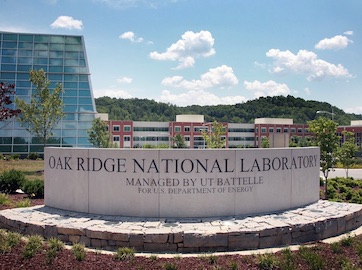Filter Results
Related Organization
- Biological and Environmental Systems Science Directorate (29)
- Computing and Computational Sciences Directorate (39)
- Energy Science and Technology Directorate
(229)
- Fusion and Fission Energy and Science Directorate (24)
- Information Technology Services Directorate (3)
- Isotope Science and Enrichment Directorate (7)
- National Security Sciences Directorate (20)
- Neutron Sciences Directorate (11)
- Physical Sciences Directorate
(138)
- User Facilities (28)
Researcher
- Adam M Guss
- Josh Michener
- Edgar Lara-Curzio
- Liangyu Qian
- Ryan Dehoff
- Venkatakrishnan Singanallur Vaidyanathan
- Vincent Paquit
- Ying Yang
- Adam Willoughby
- Amir K Ziabari
- Andrzej Nycz
- Austin L Carroll
- Bruce A Pint
- Diana E Hun
- Eric Wolfe
- Isaiah Dishner
- Jeff Foster
- John F Cahill
- Kuntal De
- Michael Kirka
- Philip Bingham
- Philip Boudreaux
- Rishi Pillai
- Serena Chen
- Stephen M Killough
- Steven J Zinkle
- Udaya C Kalluri
- Xiaohan Yang
- Yanli Wang
- Yutai Kato
- Alex Walters
- Alice Perrin
- Ben Lamm
- Beth L Armstrong
- Biruk A Feyissa
- Bishnu Prasad Thapaliya
- Brandon Johnston
- Bryan Maldonado Puente
- Carrie Eckert
- Charles Hawkins
- Chris Masuo
- Christopher Ledford
- Clay Leach
- Corey Cooke
- Debjani Pal
- Frederic Vautard
- Gerald Tuskan
- Gina Accawi
- Gurneesh Jatana
- Ilenne Del Valle Kessra
- Jay D Huenemann
- Jiheon Jun
- Joanna Tannous
- John Holliman II
- Kyle Davis
- Marie Romedenne
- Mark M Root
- Meghan Lamm
- Nidia Gallego
- Nolan Hayes
- Obaid Rahman
- Patxi Fernandez-Zelaia
- Paul Abraham
- Peter Wang
- Priyanshi Agrawal
- Ryan Kerekes
- Sally Ghanem
- Shajjad Chowdhury
- Tim Graening Seibert
- Tolga Aytug
- Vilmos Kertesz
- Weicheng Zhong
- Wei Tang
- William Alexander
- Xiang Chen
- Yan-Ru Lin
- Yang Liu
- Yong Chae Lim
- Zhili Feng

ORNL researchers have developed a deep learning-based approach to rapidly perform high-quality reconstructions from sparse X-ray computed tomography measurements.

How fast is a vehicle traveling? For different reasons, this basic question is of interest to other motorists, insurance companies, law enforcement, traffic planners, and security personnel. Solutions to this measurement problem suffer from a number of constraints.

Enzymes for synthesis of sequenced oligoamide triads and tetrads that can be polymerized into sequenced copolyamides.
Contact
To learn more about this technology, email partnerships@ornl.gov or call 865-574-1051.

We tested 48 diverse homologs of SfaB and identified several enzyme variants that were more active than SfaB at synthesizing the nylon-6,6 monomer.

We have developed thermophilic bacterial strains that can break down PET and consume ethylene glycol and TPA. This will help enable modern, petroleum-derived plastics to be converted into value-added chemicals.

By engineering the Serine Integrase Assisted Genome Engineering (SAGE) genetic toolkit in an industrial strain of Aspergillus niger, we have established its proof of principle for applicability in Eukaryotes.

We have been working to adapt background oriented schlieren (BOS) imaging to directly visualize building leakage, which is fast and easy.

V-Cr-Ti alloys have been proposed as candidate structural materials in fusion reactor blanket concepts with operation temperatures greater than that for reduced activation ferritic martensitic steels (RAFMs).

A novel method that prevents detachment of an optical fiber from a metal/alloy tube and allows strain measurement up to higher temperatures, about 800 C has been developed. Standard commercial adhesives typically only survive up to about 400 C.

We present a comprehensive muti-technique approach for systematic investigation of enzymes generated by wastewater Comamonas species with hitherto unknown functionality to wards the depolymerization of plastics into bioaccessible products for bacterial metabolism.

